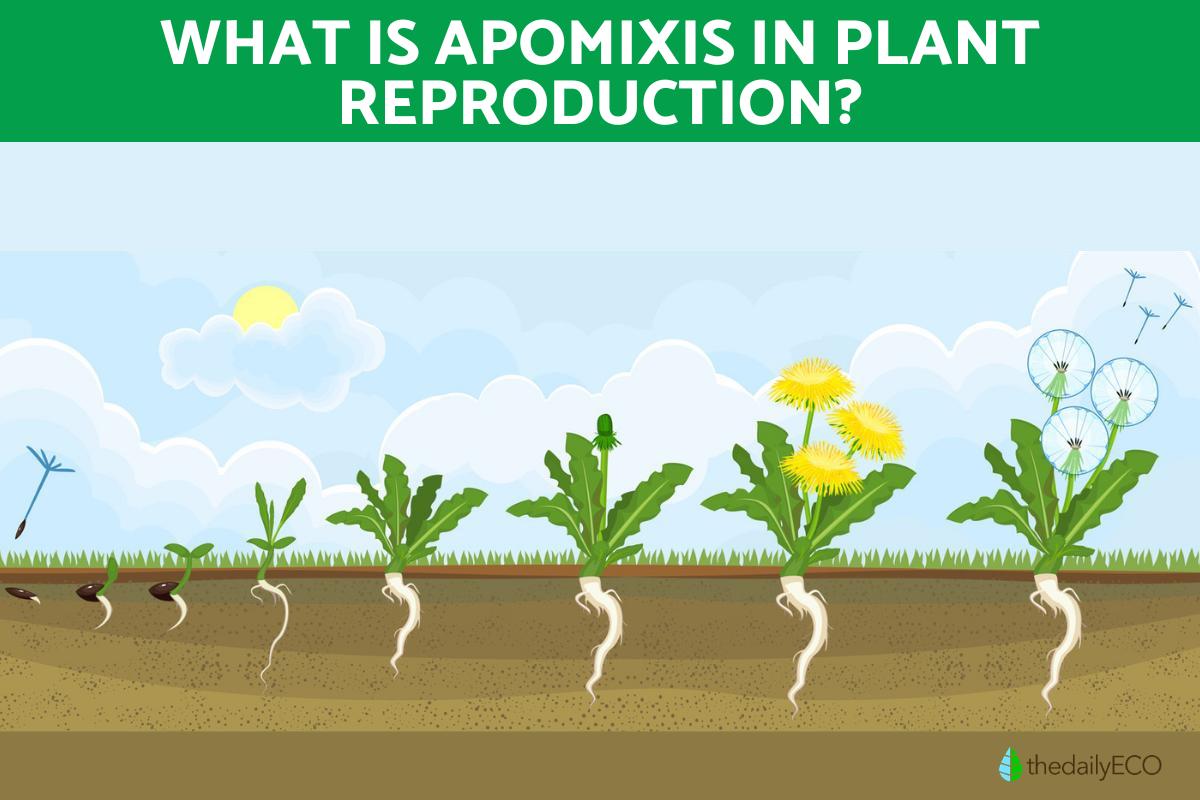What Is Apomixis and Its Types?


In the realm of biology, reproduction is a fundamental process that ensures the continuity of life. While sexual reproduction, involving the fusion of male and female gametes, is the predominant mode, plants exhibit a remarkable diversity in their reproductive strategies. Among these, apomixis stands out as a fascinating asexual reproductive mechanism that bypasses traditional sexual processes.
The following article by thedailyECO we explain what apomixis reproduction in plants is, its types, examples and biological importance
What is apomixis?
Apomixis is a biological phenomenon that deviates from the conventional sexual reproductive mode in plants. Unlike sexual reproduction, which involves the fusion of male and female gametes, apomixis enables the production of seeds without fertilization, resulting in offspring genetically identical to the mother plant. This asexual propagation method offers several advantages, including the rapid generation of uniform progeny and the avoidance of inbreeding depression.
In sexual reproduction, the fusion of male and female gametes occurs, leading to the formation of a zygote. This zygote undergoes development, giving rise to an embryo, which eventually matures into a new individual. Sexual reproduction promotes genetic diversity among offspring through the combination of traits from both parents.
In apomixis, seeds are produced without fertilization, bypassing the fusion of gametes. This results in offspring that are genetically identical to the mother plant, inheriting all her traits. Apomixis offers the advantage of rapid propagation of uniform progeny but limits genetic diversity.
The term "apomixis" was coined by Johan Henrik Wiengreen in 1908, derived from the Greek words "apo" (meaning "away") and "mixis" (meaning "mixture"). The existence of apomixis was initially met with skepticism, as it challenged the prevailing understanding of plant reproductive biology. However, subsequent research provided compelling evidence for its occurrence in various plant species.
"Delve deeper into the world of asexual reproduction in plants and animals by exploring our detailed article on the topic.

Types of apomixis
There are several types of Apomixis, and they are broadly categorized into three main types:
1. Adventitious embryony
In this type of Apomixis, embryos develop from somatic cells (non-reproductive cells) of the plant, usually in the ovule or seed. It is a form of asexual reproduction where embryos form without fertilization.
2. Gametophytic apomixis
Gametophytic apomixis involves the development of embryos from unreduced egg cells without fertilization. This process occurs within the gametophyte, the structure that produces gametes (egg and sperm cells).
There are two main pathways of gametophytic apomixis: diplospory and apospory.
- Diplospory: instead of the usual production of haploid megaspores (female gametes) in the megaspore sac, diplospory involves the direct development of an embryo without reducing the chromosome number.
- Apospory: in this case, an embryo forms directly from a sporophytic cell, like a nucellar or integument cell, within the ovule. This skips the usual formation of the megaspore sac and the subsequent development of the gametophyte.
3. Nucellar Embryony
Nucellar embryony occurs when the embryo develops from the nucellus, a part of the ovule, without the involvement of fertilization. The nucellus is a tissue surrounding the embryo sac in the ovule.
Examples of apomixis reproduction in plants
Dandelion (Taraxacum officinale)
The dandelion, a familiar sight in lawns and meadows worldwide, is a classic example of a plant that reproduces via apomixis. In dandelions, the megaspore sac, which typically produces haploid megaspores (female gametes), directly develops into an embryo without reduction in chromosome number. This results in offspring that are genetically identical to the mother plant.
Hawkweed (Hieracium spp.)
Hawkweeds, a diverse genus of flowering plants, exhibit a wide range of apomictic mechanisms. In some hawkweed species, apospory occurs, where an embryo develops directly from a sporophytic cell within the ovule. In other species, diplospory takes place, where the megaspore sac directly develops into an embryo.
Citrus (Citrus spp.)
Citrus trees, including oranges, grapefruits, and lemons, commonly reproduce via nucellar embryony. In this type of apomixis, embryos arise directly from diploid cells of the nucellus, the tissue surrounding the megaspore sac within the ovule. This results in offspring that are genetically identical to the mother plant.
Kentucky Bluegrass (Poa pratensis)
Kentucky bluegrass, a popular lawn grass, is another example of a plant that utilizes apomixis. In Kentucky bluegrass, apospory occurs, where an embryo develops directly from a sporophytic cell within the ovule. This asexual reproduction method has contributed to the widespread success of Kentucky bluegrass as a lawn grass.

Biological importance of apomixis
Apomixis stands out as a fascinating and significant biological phenomenon. This asexual mode of reproduction, bypassing the conventional sexual processes, has far-reaching implications for the evolution, ecology, and agriculture of plants.
Advantages
- Apomixis enables plants to produce genetically identical offspring rapidly, allowing for the rapid spread of advantageous traits and adaptation to local environments.
- Apomixis circumvents the negative effects of inbreeding depression, which can lead to reduced fitness and fertility in sexually reproducing plants.
Disadvantages
- Apomixis restricts genetic variation among offspring, hindering the ability of plant populations to adapt to changing environmental conditions.
- The fixation of specific traits through apomixis may prevent the incorporation of beneficial alleles from other individuals.
Apomixis plays a crucial role in shaping plant communities and ecosystems. Its ability to generate uniform offspring facilitates the spread of successful genotypes in specific habitats, contributing to the dominance of certain plant species. Additionally, apomixis can impact pollinator dynamics and plant-pollinator interactions.
Not only that but apomixis holds immense potential for agricultural and horticultural advancements. The ability to produce genetically uniform crops with desirable traits through apomixis could revolutionize crop breeding and production. However, the potential loss of genetic diversity and the need for specific traits in different environments need careful consideration.
Complement your knowledge of apomixis with an exploration of sporulation, a process that has shaped the evolutionary trajectories of countless plant and fungal species.
If you want to read similar articles to What Is Apomixis and Its Types?, we recommend you visit our Biology category.







